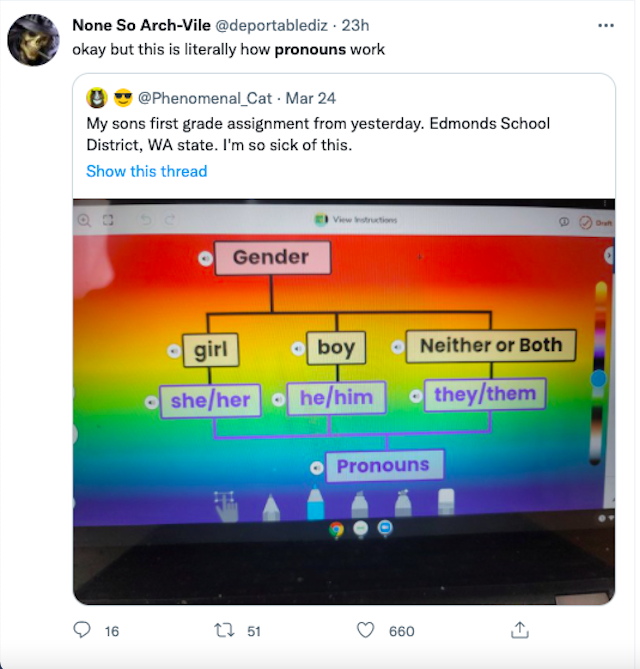Related Concepts: Ableist Language – Disability Metaphors – Disability Studies; Inclusivity – Inclusive Language



The way we use pronouns—in particular the use of the traditionally plural pronouns they/them in reference to both males and females—has recently been a subject of intense debate. This furor over pronoun use feels very current, yet linguistic scholars trace this disagreement back at least 700 years.
The initial emergence of controversy was purely grammatical: English is lacking an important part of speech. You see, pronouns are paired with antecedents, the more specific nouns that precede them. But a problem arises when a sentence uses a singular gender-neutral common noun (like student, official, or customer) because English does not have a singular gender-neutral pronoun to pair with these words.
- Example: If a student wishes to be excused from physical education, ________ must submit an appeal to the school board.
The available pronouns that agree in number with “student” in this example ask you to assume that students are all either male or female (“he” or “she”).
The pronoun debate that we are seeing litigated in the court of public opinion, however, isn’t really a grammatical debate so much as a social one. This is also not new. Pronouns have found themselves at the center of a values debate since the suffragist movement almost 200 years ago.
Why Does the Debate Over Pronouns Matter?
Pronouns themselves matter because they are a part of speech that is impossible to avoid using. Pronouns
- introduce variety into our sentences
- help us to avoid awkward repetition
- provide context and emphasis
- clarify relationships between ideas.
The debate matters because the use of pronouns has become a proxy for important social issues. The choices we make about pronoun use translates in very real ways to the dignity and rights afforded to marginalized groups.
This article will explore how we’ve traditionally addressed this grammatical conundrum as well as how pronoun use has been wielded throughout history to exclude marginalized communities.
The Generic “He,” the Singular “They,” and the History of Exclusive Language
In the absence of a singular gender-neutral pronoun, grammarians decreed that masculine pronouns—he, him, and his—could also be used generically to refer to both males and females. But this choice amounted to more than a fussy rule for grammar sticklers.
The generic “he” was written into law in 1871 as part of The Dictionary Act: “[W]ords importing the masculine gender may be applied to females [Statutes at Large, 41st Congress, session III, ch. 71, p. 431].”[1]The dual use of a pronoun was not unheard of (“you”, for instance, can be both singular and plural), but this dual use did create ambiguity, especially with regard to the interpretation of the law. Of particular importance is the word “may,” which signified that the courts had discretion in determining when the use of “he” applied also to women, and when it did not. Perhaps not coincidentally, prior to the passage of the Dictionary Act, in 1869 suffragists argued that if the use of the generic “he” in criminal law applied to women, then the generic “he” in voting law should apply to women as well.[2] Given that 19th amendment would not be ratified for another 60 years, this argument was clearly unsuccessful at the time. Because “he” could be either masculine or generic, it was up to our courts to interpret its use. Surprising no one, the courts determined that “he” in laws regarding punitive measures like jailable offenses and paying taxes applied generically, while “he” in laws related to the right to vote, the right to practice law, and the right to run for congress (among many others) applied only to men.
The rules regarding pronouns are inextricably tied to issues of gender and power, rights and equality.
This uneven application of the generic “he” reveals something important about the pronoun debate: It has never been a debate about grammar. The rules regarding pronouns are inextricably tied to issues of gender and power, rights and equality.
But the grammatical inconvenience of this missing part of speech resulted in calls for a gender-neutral singular pronouns predating even the suffragist movement. According to Dr. Dennis Baron, professor Emeritus and the University of Illinois and author of What’s Your Pronoun?, the singular “they” first appeared in writing in 1370 and in 1792, a Scottish economist suggested adopting “ou” as a gender-neutral singular pronoun.[3]
Dozens of recommended options have since followed, but none have had staying power.
She/her/hers
He/him/his
Ze/zim/zir
Ey/em/eir
Per/per/pers
Ve/vir/vis
Fae/faer/faers
Sie/sier/hir
In the absence of a widely accepted alternative, students were instructed, as noted above, to default to male singular pronouns in these cases.
- Example: If a student wishes to be excused from physical education, he must submit an appeal to the school board.
The generic “he,” hilariously described by Baron as “the grammatical equivalent of manspreading,” dates back centuries, and the reason for its adoption had little to do with clarity. Baron quotes John Lyly on this subject in 1567: “The Masculine Gender is more worthy than the Feminine, and Feminine more worthy than the Neuter.”[4]
More appalling than this reasoning is the fact that this solution remained the standard until the late 20th century, when the rule evolved into the more inclusive but much clunkier “he or she.”
- Example: If a student wishes to be excused from physical education, he or she must submit an appeal to the school board.
Even as late as 1985, though, only about half of editors surveyed preferred “he or she” over the generic “he.”[5] Beyond syntactic awkwardness, this option is also not fully inclusive. “He or she” excludes those who fall outside the gender binary.
Another option is to change the structure of the sentence to avoid the problem.
- Example: If students wish to be excused from physical education, they must submit an appeal to the school board.
However, writing around the problem is not always possible. The fact is that the lack of an ungendered singular pronoun is a failure of the English language, and the question of how to deal with it continues to be polarizing, with no option whipping up a fury otherwise unheard of in discussion of grammar more than the option to adapt “they” to be both plural and singular.
Critics of the use of the singular “they” have existed since its inception. Baron notes that in 1794, after being criticized by writer Don Alonzo for using the singular “they,” writers of the offending passage offered this arch reply: “With regard to our using the plural pronoun “them” . . . — as we wished to conceal the gender, we would ask . . . Don [Alonzo] to coin us a substitute.”[6] Aside from a feeble call for change in The Atlantic in 1879[7], the writing community seemed to side with Mr. Alonzo. As of 1985, newspaper and magazine editors surveyed continued to be overwhelmingly against the use of the singular “they.”[8]
Pronouns and Inclusivity Today
The tide appears, at long last, to be turning. Indeed “they” was the Merriam-Webster word of the year in 2019. Dr. Baron argues that the singular “they” is ideal, as it sounds natural enough that many people accidentally use it already and the larger writing community agrees. The Washington Post, which follows its own style guide, was an early adopter, switching to the use the singular “they” in 2015. The MLA and APA eventually followed suit to fully endorsed the singular “they” as well. The Associated Press, while still recommending writing around the need for a singular gender-neutral pronoun, has also okayed its use. The Chicago Manual of Style stops short of a full endorsement, and like the AP suggests write-arounds. They are unanimous, however, in their endorsement of using the singular “they” in reference to specific people. This is important: If a person’s preferred pronouns are they/them, the style books agree that the use of the singular “they” is not just polite but correct.
There are, naturally, still detractors. For those who argue against the singular “they” on grammatical grounds, I think it’s safe to say that they have missed the point.
First, the English language is evolving and has always done so. The rate at which words disappear from our lexicon is eclipsed only by the rate at which new words are added. 800-1000 new words are added to English dictionaries every year. Some of this has to do with objects we no longer use (like floppy disks), and some words simply become unfashionable (like groovy). Old English bears only a passing resemblance to its youngest descendant, and even early modern English seems foreign enough to induce genuine anxiety in teenagers toting Shakespeare home in their backpacks each night.
And the changes are not limited to our vocabulary—our grammar changes, too (albeit more slowly). “You,” for instance, was initially plural (along with “ye”, while “thee” and “thou” were the corresponding singular pronouns). Eventually “you” became singular as well, and supplanted the other pronouns. It is hard to understand how anyone who studies language enough to harbor strong opinions about grammar could find merit in the argument that English shouldn’t change.
Second, our language is a reflection of our culture, and this is where the real debate lives. The generic “he” emerged as a way of subjugating women, deemed “less worthy” so many years ago. It was used to write women out of the law and out of participation in public life. Today’s debate is a new version of the same song. When critics of the singular “they” insist on limiting us to “he” or “she,” it is an attempt to write everyone who falls outside of the gender binary not just out of participation, but out of existence.
But take heart. In the end, our language is not swayed by calls, no matter how fervent, to freeze in time. Our language changes as we do, and we have changed. The position of the major stylebooks is not a harbinger of what is to come. It is a record of a change that is already here.






















